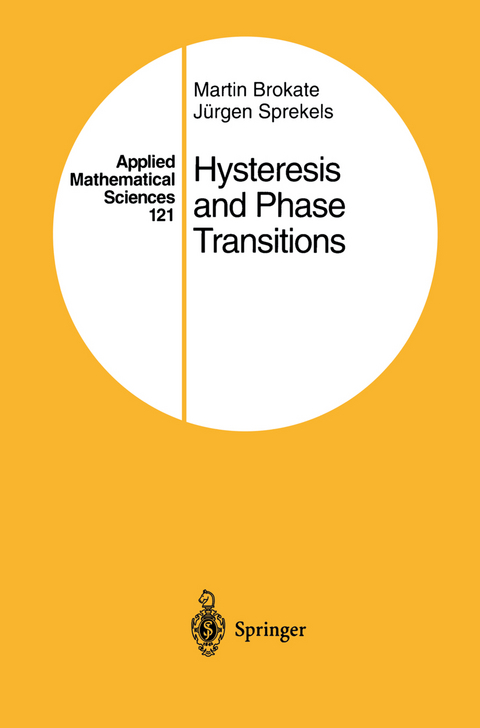
Hysteresis and Phase Transitions
Springer-Verlag New York Inc.
978-0-387-94763-1 (ISBN)
Hysteresis is an exciting and mathematically challenging phenomenon that oc curs in rather different situations: jt, can be a byproduct offundamental physical mechanisms (such as phase transitions) or the consequence of a degradation or imperfection (like the play in a mechanical system), or it is built deliberately into a system in order to monitor its behaviour, as in the case of the heat control via thermostats. The delicate interplay between memory effects and the occurrence of hys teresis loops has the effect that hysteresis is a genuinely nonlinear phenomenon which is usually non-smooth and thus not easy to treat mathematically. Hence it was only in the early seventies that the group of Russian scientists around M. A. Krasnoselskii initiated a systematic mathematical investigation of the phenomenon of hysteresis which culminated in the fundamental monograph Krasnoselskii-Pokrovskii (1983). In the meantime, many mathematicians have contributed to the mathematical theory, and the important monographs of 1. Mayergoyz (1991) and A. Visintin (1994a) have appeared. We came into contact with the notion of hysteresis around the year 1980.
1. Some Mathematical Tools.- 1.1 Measure and Integration.- 1.2 Function Spaces.- 1.3 Nonlinear Equations.- 1.4 Ordinary Differential Equations.- 2. Hysteresis Operators.- 2.1 Basic Examples.- 2.2 General Hysteresis Operators.- 2.3 The Play Operator.- 2.4 Hysteresis Operators of Preisach Type.- 2.5 Hysteresis Potentials and Energy Dissipation.- 2.6 Hysteresis Counting and Damage.- 2.7 Characterization of Preisach Type Operators.- 2.8 Hysteresis Loops in the Prandtl Model.- 2.9 Hysteresis Loops in the Preisach Model.- 2.10 Composition of Preisach Type Operators.- 2.11 Inverse and Implicit Hysteresis Operators.- 2.12 Hysteresis Count and Damage, Part II.- 3. Hysteresis and Differential Equations.- 3.1 Hysteresis in Ordinary Differential Equations.- 3.2 Auxiliary Imbedding Results.- 3.3 The Heat Equation with Hysteresis.- 3.4 A Convexity Inequality.- 3.5 The Wave Equation with Hysteresis.- 4. Phase Transitions and Hysteresis.- 4.1 Thermodynamic Notions and Relations.- 4.2 Phase Transitions and Order Parameters.- 4.3 Landau and Devonshire Free Energies.- 4.4 Ginzburg Theory and Phase Field Models.- 5. Hysteresis Effects in Shape Memory Alloys.- 5.1 Phenomenology and Falk’s Model.- 5.2 Well-Posedness for Falk’s Model.- 5.3 Numerical Approximation.- 5.4 Complementary Remarks.- 6. Phase Field Models With Non-Conserving Kinetics.- 6.1 Auxiliary Results from Linear Elliptic and Parabolic Theory.- 6.2 Well-Posedness of the Caginalp Model.- 6.3 Well-Posedness of the Penrose-Fife Model.- 6.4 Complementary Remarks.- 7. Phase Field Models With Conserved Order Parameters.- 7.1 Well-Posedness of the Caginalp Model.- 7.2 Well-Posedness of the Penrose-Fife Model.- 8. Phase Transitions in Eutectoid Carbon Steels.- 8.1 Phenomenology of the Phase Transitions.- 8.2 The MathematicalModel.- 8.3 Well-Posedness of the Model.- 8.4 The Jominy Test: A Numerical Study.
| Reihe/Serie | Applied Mathematical Sciences ; 121 |
|---|---|
| Zusatzinfo | X, 358 p. |
| Verlagsort | New York, NY |
| Sprache | englisch |
| Maße | 156 x 234 mm |
| Themenwelt | Mathematik / Informatik ► Mathematik ► Analysis |
| Mathematik / Informatik ► Mathematik ► Angewandte Mathematik | |
| Naturwissenschaften ► Physik / Astronomie ► Elektrodynamik | |
| ISBN-10 | 0-387-94763-9 / 0387947639 |
| ISBN-13 | 978-0-387-94763-1 / 9780387947631 |
| Zustand | Neuware |
| Haben Sie eine Frage zum Produkt? |
aus dem Bereich


